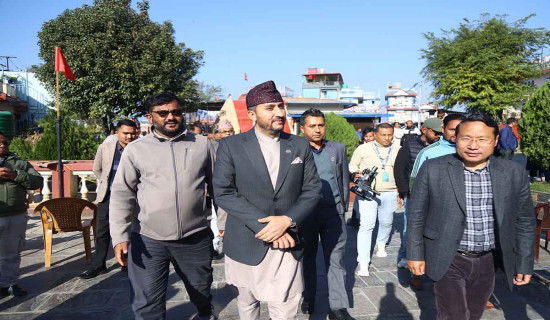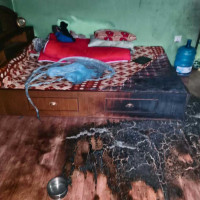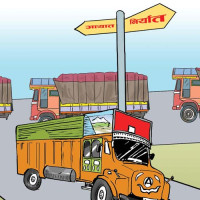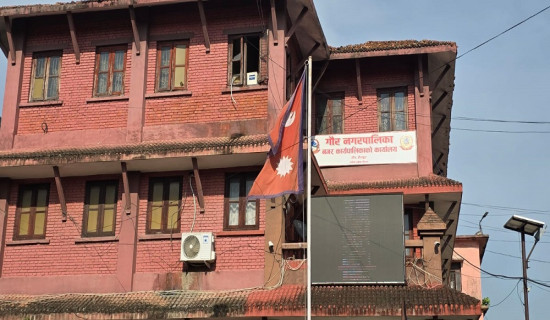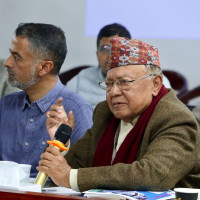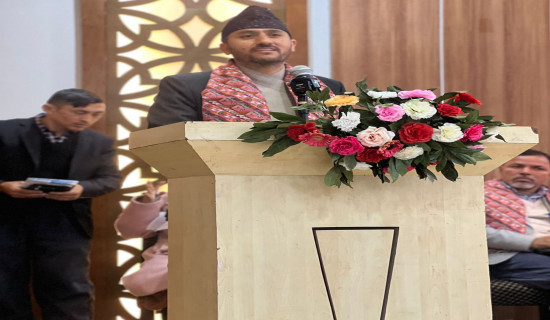- Tuesday, 23 December 2025
The Decade Of 2070s: Time Of Accomplishments And Setbacks
There probably wasn’t a decade in the history of Nepal, that witnessed more than a dozen epoch-making incidents and development other than the seventh decade of the 21st century of the Bikram Sambat Calendar (mid-April 2013 to mid-April 2023). The country not only witnessed history changing political upheavals but also natural disasters and calamities. It got a new constitution and was ushered into a federal republic changing the political map of the country and its governance system after about 54 years since King Mahendra politically divided the nation into 14 zones and 74 district in 1962.
Second CA Election
The decade started with the election of the second Constituent Assembly (CA) in November 2013. It was not an achievement but a failure of the political parties in writing a new constitution of Nepal. Although the first CA elected in May 2008 was expected to deliver a new constitution, the 601-member assembly miserably failed, and then prime minister Dr. Baburam Bhattarai handed over the reign of the government to Chief Justice of the Supreme Court, Khil Raj Regmi. The caretaker government in the chairmanship of the chief justice conducted the second elections of the Constituent Assembly. The tenure of the CA was also being wasted without much progress and constitution wouldn’t have been announced had there not been the devastating earthquake in 2015. The quake played a catalytic role in creating a political consensus among the political parties including the former rebels - CPN (Maoist).
The Gorkha Earthquake
The Gorkha Earthquake on April 25, 2015 rocked the central hills and mountains of the country and killed about 9000 people and injured as much as 22,000. The 7.8 magnitude quake and scores of its aftershocks killed over 9000 people and damaged 800,000 houses across the country while several health institutions, schools, government buildings and infrastructure were also damaged. The government conducted a large reconstruction drive supporting more than 90 per cent of the families whose houses were completely or partially damaged to rebuild and retrofit their domiciles. The National Reconstruction Authority (NRA) – an institution created to carry out the post-quake reconstruction work – signed an agreement with 790,000 beneficiaries to mobilise the government grant for house rebuilding (Rs. 300,000) and retrofitting (Rs. 100,000).
According to the estimates of the Post Disaster Needs Assessment conducted by the government with the support of the development partners in the immediate aftermath of the quake, the total value of the damages and losses caused by the disaster stood at US$7.1 billion, and about US$ 6.7 billion was needed for the recovery. In the following six years, the country successfully concluded the reconstruction of the private houses as well as public infrastructure setting an example for other disaster-prone countries. The reconstruction authority concluded its term on December 26, 2021 and handed over the remaining rebuilding of public infrastructure and cultural heritages to the respective line ministries.
Federal Constitution
Nepal got the federal constitution on September 20, 2015, approximately five months after the devastating quake hit the nation. The political parties that were fighting for even petty differences in political and social issues for the past seven years, forged a consensus to issue a new constitution. The first president of the country, Dr. Ram Baran Yadav, elected after the abolition of two-and-half centuries old monarchical system in May 2008, promulgated the constitution. The government led by Nepali Congress leader Sushil Koirala garnered support of then largest party CPN (Maoist), and CPN-UML and others to issue the constitution.
King Gyanendra who famously said that he couldn’t be the king who wouldn’t see or listen dared to sack the democratically elected government led by Sher Bahadur Deuba terming him ‘incapable’ in October 2002. He became the last king of the nation that was founded by his ancestors, chiefly king Prithvi Narayan Shah. The same populace that mourned the death of King Birendra and still revere him as one of the best kings, came out to not only overthrow King Gyanendra but also to abolish monarchy for good.
The new constitution changed the political map of the country, and the earlier divisions – five development regions, 14 zones and 75 districts – were changed to seven provinces, 77 districts and 753 local bodies. The governance system was developed into a three-tier mechanism: federal, provincial and local governments. All three governments are autonomous, they have separate laws and development policies.
Indian Blockade
The promulgation of the new federal constitution did not please many, including the Madhes-based parties and southern neighbour, India. The Madhesi parties wanted to create a single province by incorporating the entire Terai region from east to west of the country. Terai is not only the food basket of the country but also the strategic region in terms of national security and integrity because of the open border with India that encircles Nepal from three sides except in the north.
India, expressing dissatisfaction with the promulgation of the constitution, did not welcome the historic feat in Nepal and sided with the protest movements launched by the Madhes-based parties and obstructed the movement of goods to and from Nepal. It created a shortage of essential goods including petroleum fuel and medicines. Inflation rocketed causing panic in the part of the consumers who were doomed to pay up to Rs. 700 for a litre of petrol which had become a scarce commodity overnight. Long-haul transportation was severely affected and supply of LP gas was limited. The government started to sell firewood at various locations in the country including the Kathmandu Valley to meet the public demand for cooking fuel. The third blockade imposed by India to Nepal in the wake of the devastating earthquake pushed the country into an economic distress. As a result, the country could achieve the economic growth of just 0.43 per cent.
Connectivity With China
The India-imposed blockade forced the political leadership in Nepal to find an alternative route for trade and supply of essential goods. And, it was only the Chinese side. But the connectivity with the northern neighbour was obstructed by the high Himalayas and difficult topography as well as lack of large economic hubs in China near the border. The government led by KP Sharma Oli was successful to find a national consensus to expand connectivity with China. The government immediately deployed the Nepali Army to open track from Betrawati in Rasuwa to Rasuwagadhi in Nepal-China border. Likewise, in December 2015, Nepal signed an agreement with China to promote a long-term trade of petroleum oil and cooking gas. Deputy Prime Minister and Minister for Foreign Affairs Kamal Thapa and his Chinese counterpart Wang Yi, signed the agreement in Beijing.
Meanwhile, the process to sign trade and transit treaty, gain access to sea through China were also started. Later in 2018, PM Oli signed various agreements, protocols and memorandum of understandings with China on energy cooperation, reconstruction, infrastructure development, investment and using Tibetan Highway for goods transportation. In the same year, China allowed Nepal to use its seaports in Tianjin, Shenzhen, Lianyungang and Zhanjiang, and dry ports in Lanzhou, Lhasa and Xigatse for trading with third countries.
Likewise, in 2022, Foreign Minister, Dr. Narayan Khadka and his Chinese counterpart Wang Yi signed another stack of agreements including on economic and technical cooperation, China-aided feasibility study of China-Nepal cross-border project, and power grid connections, duty free entry of 98 per cent Nepali goods, and cooperation on railway sector. However, Nepal couldn’t benefit from these agreements as the border remained completely or partially shut due to the COVID-19 pandemic since early 2020 till now.
Elections In Federal Structure
Nepal successfully held two elections after the country adopted a federal structure in 2015. The elections were held on 14 May, 28 June and 18 September 2017 for the local governments in 753 local bodies. Likewise, elections for the federal parliament was organised in 26 November and 7 December same year that elected 275 representatives – 165 from the first-past-the-post and 110 from proportional representation system. The second elections were held in 20 November 2022. Similarly, the country held two elections for 550 provincial assembly members – including 220 from proportional representation system.
Political Instability
The recent scenario of politics in the country is not so encouraging with its reversal to instability, contrary to the hopes of people that the country would see better politics in the federal structure and three levels of the government would do their best to satisfy the development, economic and social needs of people. Even the two-third majority government led by KP Sharma Oli of Nepal Communist Party (formed after the unification of then CPN-UML and CPN-Maoist Centre) couldn’t complete its full term. The NCP is now fragmented into three parties with one led by Pushpa Kamal Dahal Prachanda, the other by Madhav Kumar Nepal in the ruling coalition made with the largest party Nepali Congress. KP Oli is leading the main opposition party in the parliament.
Political instability had its immediate repercussions on the development works and the national economy. The country that was trying to recover from the impact of the COVID-19 pandemic lost its grip over the fiscal management and it was pushed into economic distress with external sector pressure amidst growing demand and supply side constraints created by Russia-Ukraine War and liquidity shortage in the financial system, spiraling inflation and high bank interest rates.
Alternative Political Avenues
The political bickering with making and breaking of political coalition to win election and stay in power, and indifference of the government towards the development and economic growth as well as job creation increased public attraction to alternative political forces. The large political parties lost a significant number of seats to newly formed Rastriya Swatantra Party (RSP) led by Rabi Lamichhane and the right-wing Rastriya Prajatantra Party (RPP) led by Rajendra Lingden.
The RSP won 20 seats in the HoR at its maiden participation in the polls with 815,023 votes last year. In many constituencies, the RSP candidates were trailing behind the winners. Similarly, RPP won 14 seats in 2022. It had only one seat in the HoR in 2017. The RPP increased its total number of votes to 588,849 from 196,782 five years ago.
The CPN-MC could win 32 seats in 275-member House of Representatives in 2022 while it had won 53 seats in 2017. Total votes obtained by the party came down to 1.17 million in 2022 from 1.30 million in 2017 and 3.14 million in 2008. The CPN-UML’s seats decreased to 78 in 2022 from 121 in 2017. However, the total number of votes of the party increased to 3.23 million from 3.08 million five years earlier. Although the Nepali Congress resurrected it in terms of the seats which went up to 89 from 63 in 2017, it lost a significant number of votes. It had obtained 3.59 million votes in 2017 but only 2.43 million in 2022.
Precisely 385 independent candidates won various posts, including 13 mayors/chairpersons, 4 deputy mayors/vice-chairpersons, 137 ward chairs and 232 ward members, in the local elections held in 2022. Of them mayoral candidates Balendra Shah in Kathmandu, Harka Sampang Rai in Dharan and Gopi Hamal in Dhangadhi not only achieved historical win but also found a novel way to conduct the works of the local governments.
Coronavirus Pandemic
Coronavirus pandemic and subsequent lockdowns imposed to save people from the viral infection brought the economic activities to a standstill. The pandemic killed 12,021 people while millions of others were temporarily or permanently stayed out of job. Governments at the centre and provinces announced coronavirus-centred budget for 2021/22.
The central bank announced various facilities including interest rate discount, concessional loans and refinancing facility to businesses and industries. The pandemic damaged the hard earned economic growth trajectory in the immediate aftermath of the earthquake and the country witnessed a negative economic growth.
Some sectors lost a huge amount to the pandemic. For instance, tourism lost more than 16 per
cent in 2019/20.
Notable Economic Strides
In the last one decade, the country completed Gautam Buddha International Airport, Pokhara International Airport, Nepal India Petroleum Pipeline, and Upper Tamakoshi Hydroelectricity Project but more than a dozen national pride projects are sick and adding economic burden to the country instead of forming capital.
The government has failed to bring the two large airport in Bhairahawa and Pokhara into operation which has impacted the existing and new businesses opened in the two cities in a hope that the airports would cause an influx of tourists and passengers and they would get good business. One of the good news meanwhile was the starting of electricity
export to India.
In terms of economic growth, the high growth trajectory of above 6 per cent (with 8.98 per cent in 2016/17) from 2016/17 to 2018/19 was disrupted by the COVID-19 pandemic and the economy went negative by 2.37 per cent in 2019/20. Although the economy is projected to gain the growth rate of 5.84 per cent in the current fiscal year, high inflation rate of above 7 per cent with up to 14 per cent of some food items, high interest rate, and fiscal mismanagement by both the public and private sector has troubled the economic activities and growth prospects.
(Dhakal is a Journalist at TRN)



